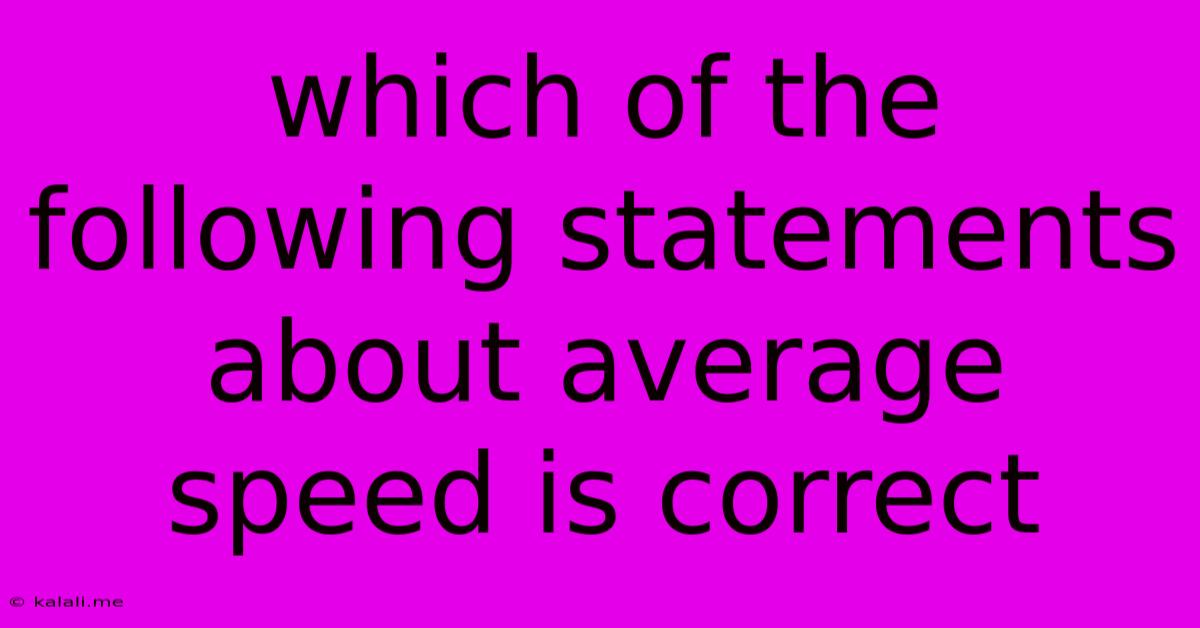Which Of The Following Statements About Average Speed Is Correct
Kalali
Jun 15, 2025 · 3 min read

Table of Contents
Which of the Following Statements About Average Speed is Correct? A Deep Dive into Understanding Average Speed
Understanding average speed is crucial in various fields, from physics and engineering to everyday travel planning. This article clarifies common misconceptions and definitively answers the question: which statement about average speed is correct? We will explore the concept, dissect common errors, and provide clear examples to solidify your understanding. This will also cover related concepts like instantaneous speed and the difference between speed and velocity.
What is Average Speed?
Average speed is a scalar quantity representing the total distance traveled divided by the total time taken. It doesn't consider the direction of travel, only the magnitude of the distance covered. This is a key distinction from average velocity, which does account for direction. The formula for average speed is:
Average Speed = Total Distance / Total Time
Common Misconceptions and Incorrect Statements:
Let's address some common misunderstandings surrounding average speed before we identify the correct statement. Many people incorrectly assume that:
-
Average speed is simply the arithmetic mean of individual speeds: This is false. If you travel at 60 mph for one hour and 30 mph for another hour, your average speed isn't (60+30)/2 = 45 mph. This calculation is flawed because it ignores the different time intervals spent at each speed.
-
Average speed considers changes in direction: This is incorrect. Average speed is a scalar quantity, meaning it only cares about the magnitude of the distance, not its direction.
-
Average speed is always less than the maximum speed: While often true, it's not always the case. If you maintain a constant speed throughout your journey, your average speed will equal your constant speed.
The Correct Statement about Average Speed:
The correct statement regarding average speed is the one that accurately reflects the definition – that it is the total distance covered divided by the total time taken. Any statement that deviates from this fundamental definition is incorrect. For instance, a correct statement might be:
"The average speed of an object is the total distance it travels divided by the total time taken to travel that distance."
Examples illustrating the correct calculation:
Example 1: A car travels 120 miles in 2 hours. Its average speed is 120 miles / 2 hours = 60 mph.
Example 2: A cyclist travels 10 km in 30 minutes (0.5 hours) then rests for 30 minutes before cycling another 20 km in 1 hour. The total distance is 30 km, and the total time is 2 hours. The average speed is 30 km / 2 hours = 15 km/h. Note that the rest time is included in the total time.
Instantaneous Speed vs. Average Speed:
It's important to distinguish between instantaneous speed and average speed. Instantaneous speed is the speed at a specific moment in time, while average speed considers the entire duration of the journey. Your speedometer shows your instantaneous speed.
Conclusion:
Understanding the true meaning of average speed is vital. Remember, it's the total distance divided by the total time, regardless of variations in speed or direction throughout the journey. Avoid common pitfalls by sticking to the fundamental formula and focusing on the total distance and total time elapsed. This clear understanding will help you accurately calculate and interpret average speed in various contexts.
Latest Posts
Latest Posts
-
What Is A Major Element Found In Bones
Jun 15, 2025
-
What Is The Storage Form Of Glucose In Plants
Jun 15, 2025
-
Which Is Heavier Kilograms Or Pounds
Jun 15, 2025
-
Identify The True And False Statements About Survey Research
Jun 15, 2025
-
Chromosomes Are Primarily Composed Of Dna And
Jun 15, 2025
Related Post
Thank you for visiting our website which covers about Which Of The Following Statements About Average Speed Is Correct . We hope the information provided has been useful to you. Feel free to contact us if you have any questions or need further assistance. See you next time and don't miss to bookmark.